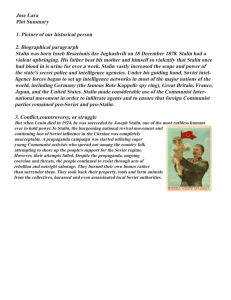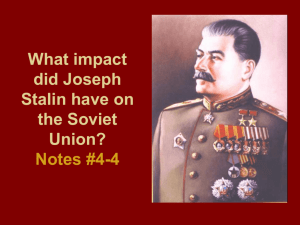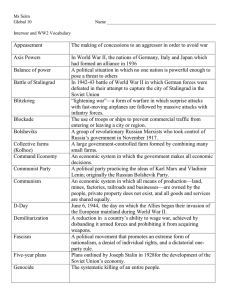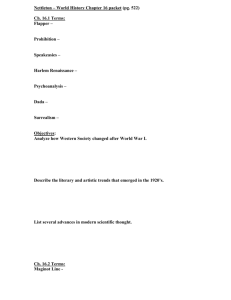Soviet_Realism_IA_example - IB 20th c. World History Y2
advertisement
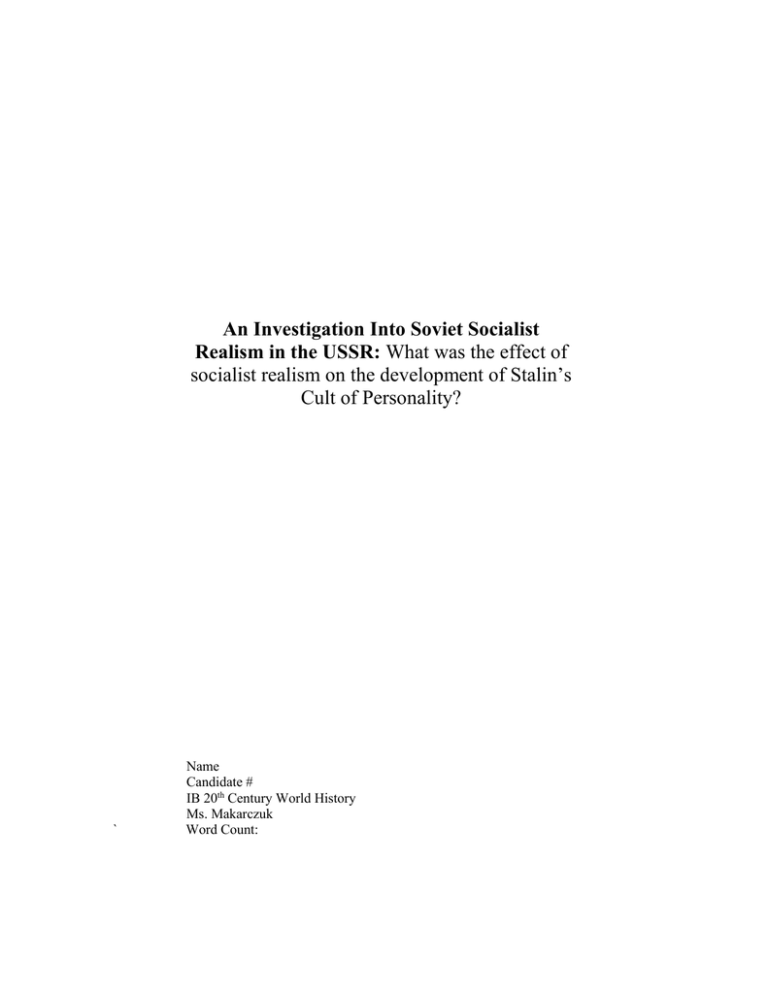
An Investigation Into Soviet Socialist Realism in the USSR: What was the effect of socialist realism on the development of Stalin’s Cult of Personality? ` Name Candidate # IB 20th Century World History Ms. Makarczuk Word Count: Candidate # Table of Contents Section A: Plan of Investigation ........................................................................................... 3 Section B: Summary of Evidence ......................................................................................... 4 Section C: Evaluation of Sources .......................................................................................... 8 Section D: Analysis .................................................................................................................10 Section E: Conclusion .............................................................................................................13 Section F: Works Cited ..........................................................................................................14 Appendix 1 ................................................................................................................................15 2 Candidate # Section A: Plan of Investigation Research will be conducted to assess the question: what was the effect of socialist realism on the development of Stalin’s cult of personality? Through the prevalence of Stalin’s image in soviet artwork and the general simultaneity of the two aspects of the soviet era, a relationship between the two could be expected. To investigate this relationship, primary and secondary documents concerning the development of soviet socialist realism will be consulted to evaluate the foundation of Stalin’s cult of personality. However sources of research will be limited to the two aspects of the soviet era, and consequently will not include information on the Great Terror. Word Count: 104 3 Candidate # Section B: Summary of Evidence Definition of Socialist Realism Soviet socialist realism is a form of expression that emphasized essential beliefs of the Soviet Era1 that emerged as an attempt by the Soviet communist party to promote fundamental aspects of socialism in Soviet cultural.2 Socialist realist work was intended for comprehension by the masses to portray socialism through the glorification of Stalin as party leader.3 4 Artists were required to denounce formalism in recognition that it represented art without content,5 and advised to depict typical characters in typical circumstances to reflect realist style.6 Socialist realist artwork depicts the hardening of people in the USSR under Stalin from the struggle of socialism.7 Creation and Development of Socialist Realism Socialist Realism became a popular style of realistic art in the 1930s, and was first adopted by the Congress of Soviet Writers in 1934.8 9 10 The goal of the proletariat was to 1 Edward M. Swiderski, review of Soviet Socialist Realism: Origins and Theory, by C. Vaughan James, Studies in Soviet Thought, October 1977, pg 247, accessed February 13, 2014, JSTOR. http://www.jstor.org/stable/20098748. 2 Ibid., 3 A. I. Stetsky, "Under the Flag of the Soviets, Under the Flag of Socialism" (speech, Soviet Writers Congress 1934, Moscow, August 1934), accessed February 13, 2014, Marxists Internet Archive. http://www.marxists.org/subject/art/lit_crit/sovietwritercongress/resolutions.htm. 4 Boris Ieremeevich Vladimirski, Roses for Stalin, 1949, accessed February 13, 2014, Marxists Internet Archive. https://www.marxists.org/subject/art/visual_arts/painting/exhibits/socialistrealism/th-roses-stalin.jpg. 5 Stetsky, "Under the Flag of the Soviets, Under the Flag of Socialism" 6 Ibid., 7 Ibid., 8 Ibid., 9 Jeffrey Brooks, "Socialist Realism in Pravda: Read All about It!," Slavic Review 53, no. 4 (Winter 1944): 975, accessed February 13, 2014, JSTOR. http://www.jstor.org/stable/2500842. 4 Candidate # unite under socialism through the control of art and literature and promotion of socialist ideology.11 Due to the repressive nature of government upon the proletariat, the party had to aide writers by fostering cultural ideology while not impeding on creativity.12 Referred to as people’s art, where the people produced artists from workers and collective farms, allowing the two to form one whole establishing golden age of art in the socialist era.13 The Communist Party supported free creative competition,14 yet controlled printing establishments to ensure correct use and leadership of literature.15 Emersion of the style marked the beginning of a cultural revolution brought about by the growing cultural demands created by a broadening of worldview as a function of revolution.16 First Congress of Soviet Writers A congress of soviet writers from all over the USSR held in August of 1934 with the political intention of uniting the intelligentsia under the flag of socialism by promoting free discussion of literary discontent.17 The organizational committee met with the Party prior to determining the program, however A.I. Stetsky, manager of the Culture and Leninist Propaganda Section of the Communist Party of the Soviet Union assured writers in attendance that the relationship between the two governing bodies was not an effort to establish a platform or infringe on creative enterprise.18 The CPSU claimed the desire for 10 Stetsky, "Under the Flag of the Soviets, Under the Flag of Socialism.” "On the Policy of the Party in the Sphere of Artistic Literature," Pravda (Moscow), July 1, 1925, accessed February 13, 2014, http://www.sovlit.net/decreejuly1925/. 12 Ibid., 13 Ibid., 14 "On the Policy of the Party in the Sphere of Artistic Literature," Pravda 15 Ibid., 16 Ibid., 17 Stetsky, "Under the Flag of the Soviets, Under the Flag of Socialism" 18 Ibid., 11 5 Candidate # socialist realism came from writers, and the essence of the style was most accurately conveyed through their works.19 Membership of the Union of Soviet Writers was essential for USSR writers due to threat of persecution.20 Speeches titled socialist realism the guiding line of literature without limitation on creative freedom.21 The congress was a success and became the center of attention of the USSR,22 and was referred to as a celebration of rich cultural heritage marking a new era in the history of Soviet literature.23 The Development of Socialist Realism in Literature The publication of Stalin’s 50th birthday in 1929 marked his emergence as primary focus in literature24 where journalists created an idealized image of Soviet Society.25 The Communist Party emphasized literature intended for the masses,26 and promoted greater coverage of the arts after the Congress of Soviet Writers27 as socialist journals emerged as primary news sources in the USSR.28 The USSR was referred to as a “fraternal family”29 where Stalin was the unquestioned head.30 The start of Stalin’s fatherly image came from a 1935 picture with a young girl, Nina Zdrogova published in Pravda along 19 Ibid., Hilary Chung et al., eds., In the Party Spirit: Socialist Realism and Literary Practice in the Soviet Union, East Germany and China (Amsterdam: Rodopi, 1996), Google Books. 21 Ibid., 22 Ibid., 23 Ibid., 24 Jan Plamper, "Georgian Koba or Soviet 'Father of Peoples'? The Stalin Cult and Ethnicity," in The Leader Cult in Communist Dictatorships: Stalin and the Eastern Bloc, ed. Balàzs Apor, Jan C. Behrends, Polly Jones, and E. A. Rees (Basingstoke, Hampshire: Palgrave Macmillan, 2004), 123, accessed February 13, 2014, http://library.mpib-berlin.mpg.de/ft/jp/JP_Georgian_2004.pdf. 25 Jeffrey Brooks, "Socialist Realism in Pravda: Read All about It!," 975 26 "On the Policy of the Party in the Sphere of Artistic Literature," Pravda 27 Jeffrey Brooks, "Socialist Realism in Pravda: Read All about It!," 975 28 Ibid., 29 Stetsky, "Under the Flag of the Soviets, Under the Flag of Socialism" 30 Jan Plamper, "Georgian Koba or Soviet 'Father of Peoples'? The Stalin Cult and Ethnicity," in The Leader Cult in Communist Dictatorships: Stalin and the Eastern Bloc, 124 20 6 with the story “I gave a bouquet to Stalin!” 31 32 Candidate # An image titled “Happy Childhood Day” depicts Stalin embracing a small girl, which was published on the front page of Pravda and later hung in public buildings.33 The phrase, “Thank you Dear Comrade Stalin for a Happy Childhood!” was put over the doorways of nurseries and schools.34 Representation of Stalin in Socialist Realism Stalin was rarely depicted as Georgian.35 He was depicted in a similar style focusing on his moustache and friendly eyes, and was usually dressed in an army uniform or a white naval uniform.36 Stalin was associated with terms such as “leader,” “teacher,” and “father,” and was described as “great,” “wise,” or “benevolent”.37 He was often pictured with non-Russian preadolescent girls38 and depicted as Lenin’s legitimate successor.39 Stalin was often portrayed as a paternal figure.40 Word Count: 656 31 Jan Plamper, "Georgian Koba or Soviet 'Father of Peoples'? The Stalin Cult and Ethnicity," in The Leader Cult in Communist Dictatorships: Stalin and the Eastern Bloc, 124 32 Catriona Kelly, "Chapter 3: 'Thank You, Dear Comrade Stalin, for a Happy Childhood!', 19351953," in Children's World: Growing Up in Russia, 1890-1991, 93. 33 Ibid., 34 35 Ibid., Jan Plamper, "Georgian Koba or Soviet 'Father of Peoples'? The Stalin Cult and Ethnicity," in The Leader Cult in Communist Dictatorships: Stalin and the Eastern Bloc, 124 36 Ibid., 37 Ibid., 38 Ibid., 39 Ibid., 40 Vladimirski, Roses for Stalin 7 Candidate # Section C: Evaluation of Sources Source A:41 A. I. Stetsky was the Manager of the Culture and Leninist Propaganda Section of the C.P.S.U. who delivered a speech at the First Soviet Writers Congress in August of 1934 addressing intentions of the Communist Party for the development of literature in the USSR. Stetsky emphasized the importance of expressing socialist realism, and uniting all nations of the USSR through the common promotion of socialist ideals. Stetsky proposed simultaneous promotion of socialist unity and creative competition while refuting accusations of the Communist Party censuring artistic expression. Stetsky defined socialist realism as the artistic representation of socialist ideals through the depiction of typical characters in typical circumstances. The source analyzes the Party’s intentions of promoting socialist realism to the public, indicating that the artistic style was not introduced with the intention of creating a cult of personality around Stalin’s image as evidenced by Stetsky’s denial of the Party’s hidden agenda. However, the origin implies limitation in value given that the speech was to promote the development of socialist realism in soviet literature, thus limiting Stetsky from addressing true motives if they did not reflect well on the Party. 41 Stetsky, "Under the Flag of the Soviets, Under the Flag of Socialism" 8 42 Candidate # Source B: (Appendix 1) Roses for Stalin is a socialist realist painting by Boris Vladimirski from 1949. It depicts Stalin in a naval uniform surrounded by youth handing him flowers and looking to him in admiration. Stalin is represented as a strong central figure, with a paternal instinct depicted through his body language. The value of this image lies in the evident duality of function as both socialist realist artwork and Stalinist propaganda. It reveals the nature of the application and development of socialist realism as a medium for legitimizing Stalin’s rule through the creation of a cult of personality around his image. The ambiguity surrounding the painting’s creation is an apparent limitation, as Vladimirski’s intentions remain unknown. It is unclear whether it was created out of nationalism or as a product of Party censorship and instilled fear. Regardless of uncertainty in purpose, the value remains constant. The image reveals how Stalin was depicted to the public through socialist realism as a leading figure instilling confidence among the population characteristic of his cult of personality. Word Count: 358 42 Vladimirski. Roses for Stalin. 9 Candidate # Section D: Analysis The consideration of the development of socialist realism in the Soviet Union as the predominant artistic style during Stalin’s regime is relevant in the evaluation of the foundation of his cult of personality due to the relative simultaneity and commonality between the two. While Stalin’s emergence as the central figure in soviet art could be attributed to his appearance in Pravda in 1929,43 his role as the unifying image of the USSR continued to develop into the 1930s. In comparison, the official acceptance of socialist realism by the Communist Party occurred during the First Congress of Soviet Writers of 1934, evidently coinciding with the development of Stalin’s cult of personality. Given that socialist realism was enforced by the Communist Party in the mid 1930s, it cannot be considered the singular cause of Stalin’s cult of personality. However the introduction of socialist realism in the USSR had an apparent impact on the development of soviet nationalism as evidenced by Stalin’s depiction in socialist realist art and literature. Stalin was uniformly depicted as the strong central character of soviet art, thus instilling a sense of nationalist pride in the population. A cult of personality was created around Stalin through a multimedia approach 44 that emphasized the federation above ethnoterritories resulting in the effective unification of nationalities under one Soviet Union.45 He embodied the bifurcated nature of ethnicity from the duality of his Georgian nationality and soviet identity46 thus establishing a unifying 43 Jan Plamper, "Georgian Koba or Soviet 'Father of Peoples'? The Stalin Cult and Ethnicity," in The Leader Cult in Communist Dictatorships: Stalin and the Eastern Bloc, 124 44 Ibid., 45 Ibid., 46 Ibid., 10 national identity. 47 Candidate # This development of soviet identity through art was a function of Communist Party control over publication, thus making it a contribution to the development of Stalin’s cult of personality. While A. I. Stetsky ensured the Russian public that the Party’s support of the socialist realist movement was not politically motivated,48 there is a comparability with the purpose of soviet realist work and work that perpetuated the development of Stalin’s idolization. While initially created with the intention of depicting ordinary soviet life, socialist realism became a medium through which to exploit its appeal to the masses by serving as a functional propaganda tool emphasizing the fundamental ideals of the Communist Party. While Stestky claimed socialist realism was a product of union desires to “create works imbued with the spirit of socialism,”49 he does not deny the Party’s involvement in the adoption and development of the style. As the “people’s art,” socialist realism supposedly depicted the creativity of the proletariat class,50 however the innate repression of the proletariat class fundamental of totalitarian governments implies that interference from the Party was be necessary in order to establish functional cultural ideology, subsequently relinquishing creative control of the arts over to the Communist Party. Artists and writers were threatened to denounce formalism and join the Union of Soviet Writers, through which the only method of publication were the printing establishments controlled by the party.51 Such 47 Ibid., 48Stetsky, "Under the Flag of the Soviets, Under the Flag of Socialism" 49 Ibid., Ibid., 51 Ibid., 50 11 Candidate # monopolization of media outlets led to the acceptance of socialist realist works due to a lack of alternative. Given that the Communist Party had absolute control over the production of the arts it is evident that Stalin’s image presented to the public was censored. Stalin was portrayed as a strong figure, associated with descriptions of power and leadership that instilled confidence and loyalty within the population. Depicting Stalin with children invoked a familial love within the population towards their leader, thus evoking an emotional response eternally linked to his image. From a soviet perspective, socialist realism could be viewed as an effort by the Party to unite the arts under a common socio-esthetic rather than utilized as a means of political control and censorship.52 However, the development of socialist realism in the USSR could be attributed to the inflexibility of the ruling party as demonstrated by the role of the CPSU exemplified by AI Stetsky’s speech. The style was imposed on writers and organizations through the simultaneous monopolization of media publication and threat of severe punishment.53 54 As a result, art became politically driven and lost public identification,55 but became more plentiful thus creating a growth of soviet culture centered on Stalin’s image.56 Word Count: 672 52 Ibid., Swiderski, review of Soviet Socialist Realism: Origins and Theory, by C. Vaughan James, 247 54 Jeffrey Brooks, "Socialist Realism in Pravda: Read All about It!," 975 55 Ibid., 56 Stetsky, "Under the Flag of the Soviets, Under the Flag of Socialism" 53 12 Candidate # Section E: Conclusion While the introduction of socialist realism to soviet society and the foundation of Stalin’s cult of personality do not have a direct causational relationship, it is evident that both contributed to the simultaneous development of the other. Contrary to claims made by the Communist Party, socialist realism was introduced into soviet society with the intention of portraying socialist values as evidenced by their monopolization of printing establishments responsible for the distribution of literature and art to the masses. Party control of publications implies control of information presented to the public, thus indicating a censured depiction of Stalin’s image as the leader of the Soviet Union. Socialist realism under the Communist Party evolved into a medium for establishing Soviet nationalism through the presentation of Stalin as a man of power and leadership. Artistic works published during the era both reflect and reinforce Stalin’s existence as the central figure in the USSR through Stalin’s paternal depiction and the continued development of a cult of personality. Stalin’s reemergence into the public eye in 1929 allowed for the evolution of his image as a symbol of nationalism and political unification, which was amplified by stylistic techniques utilized in soviet realism as monitored by the Communist Party. Word Count: 202 13 Candidate # Section F: Bibliography Works Cited Bowlt, John E. "Stalin as Isis and Ra: Socialist Realism and the Art of Design." The Journal of Decorative and Propaganda Arts 24 (2002): 34-63. Accessed February 13, 2014. JSTOR. http://www.jstor.org/stable/1504182. Brooks, Jeffrey. "Socialist Realism in Pravda: Read All about It!" Slavic Review 53, no. 4 (Winter 1944): 973-91. Accessed February 13, 2014. JSTOR. http://www.jstor.org/stable/2500842. Chung, Hilary, Michael Falchikov, B. S. McDougall, and K. McPherson, eds. In the Party Spirit: Socialist Realism and Literary Practice in the Soviet Union, East Germany and China. Amsterdam: Rodopi, 1996. Google Books. Kelly, Catriona. "Chapter 3: 'Thank You, Dear Comrade Stalin, for a Happy Childhood!', 1935-1953." In Children's World: Growing Up in Russia, 1890-1991, 93-130. New Haven: Yale University Press, 2007. "On the Policy of the Party in the Sphere of Artistic Literature." Pravda (Moscow), July 1, 1925. Accessed February 13, 2014. http://www.sovlit.net/decreejuly1925/. Plamper, Jan. "7. Georgian Koba or Soviet 'Father of Peoples'? The Stalin Cult and Ethnicity." In The Leader Cult in Communist Dictatorships: Stalin and the Eastern Bloc, edited by Balàzs Apor, Jan C. Behrends, Polly Jones, and E. A. Rees, 123-36. Basingstoke, Hampshire: Palgrave Macmillan, 2004. Accessed February 13, 2014. http://library.mpib-berlin.mpg.de/ft/jp/JP_Georgian_2004.pdf. Stetsky, A. I. "Under the Flag of the Soviets, Under the Flag of Socialism." Speech, Soviet Writers Congress 1934, Moscow, August 1934. Accessed February 13, 2014. Marxists Internet Archives. http://www.marxists.org/subject/art/lit_crit/sovietwritercongress/resolutions.htm. Swiderski, Edward M. Review of Soviet Socialist Realism: Origins and Theory, by C. Vaughan James. Studies in Soviet Thought, October 1977. Accessed February 13, 2014. JSTOR. http://www.jstor.org/stable/20098748. Vladimirski, Boris Ieremeevich. Roses for Stalin. 1949. Accessed February 13, 2014. Marxists Internet Archives. https://www.marxists.org/subject/art/visual_arts/painting/exhibits/socialist-realism/throses-stalin.jpg. 14 Candidate # Appendix 1 57 57 Vladimirski. Roses for Stalin. 15

